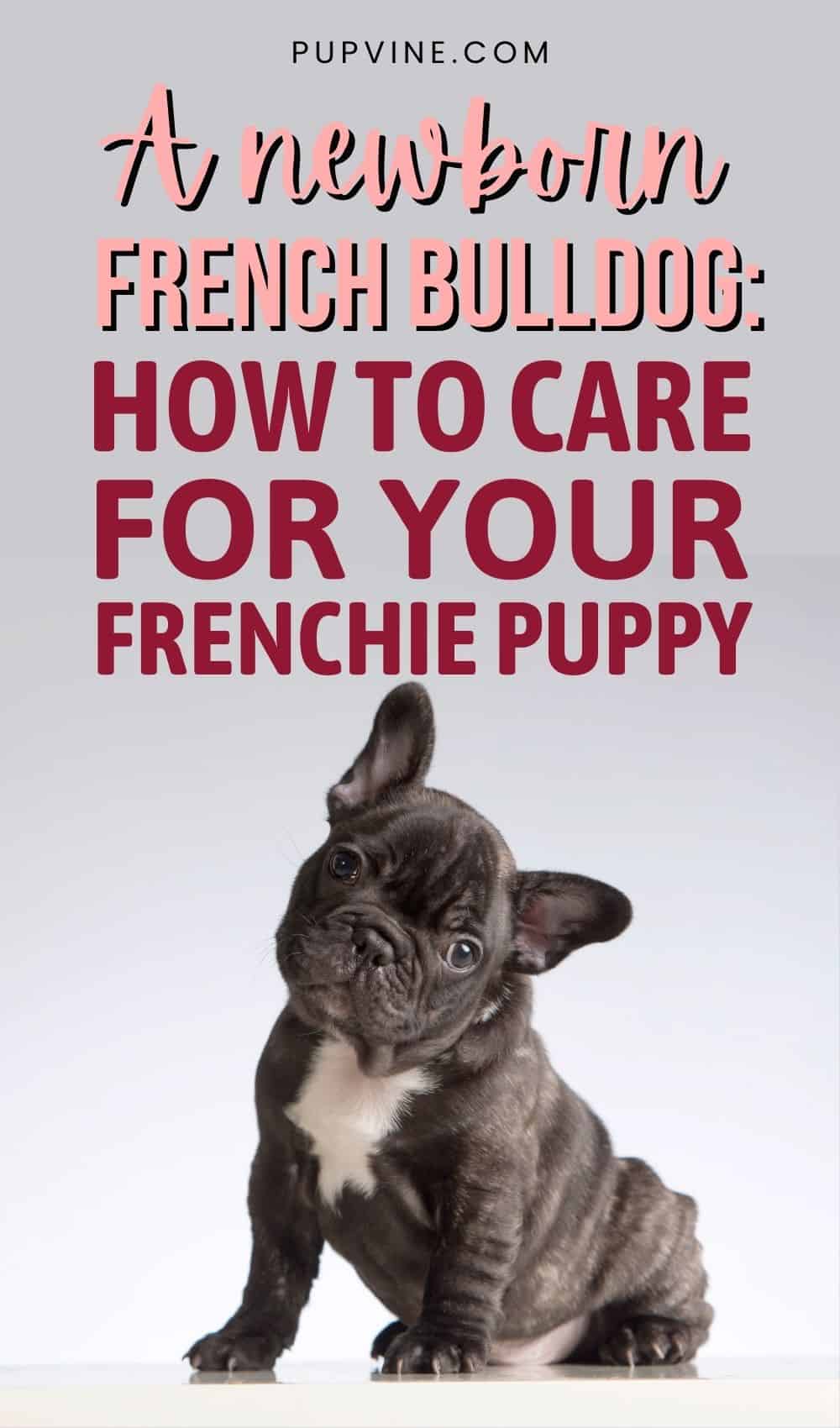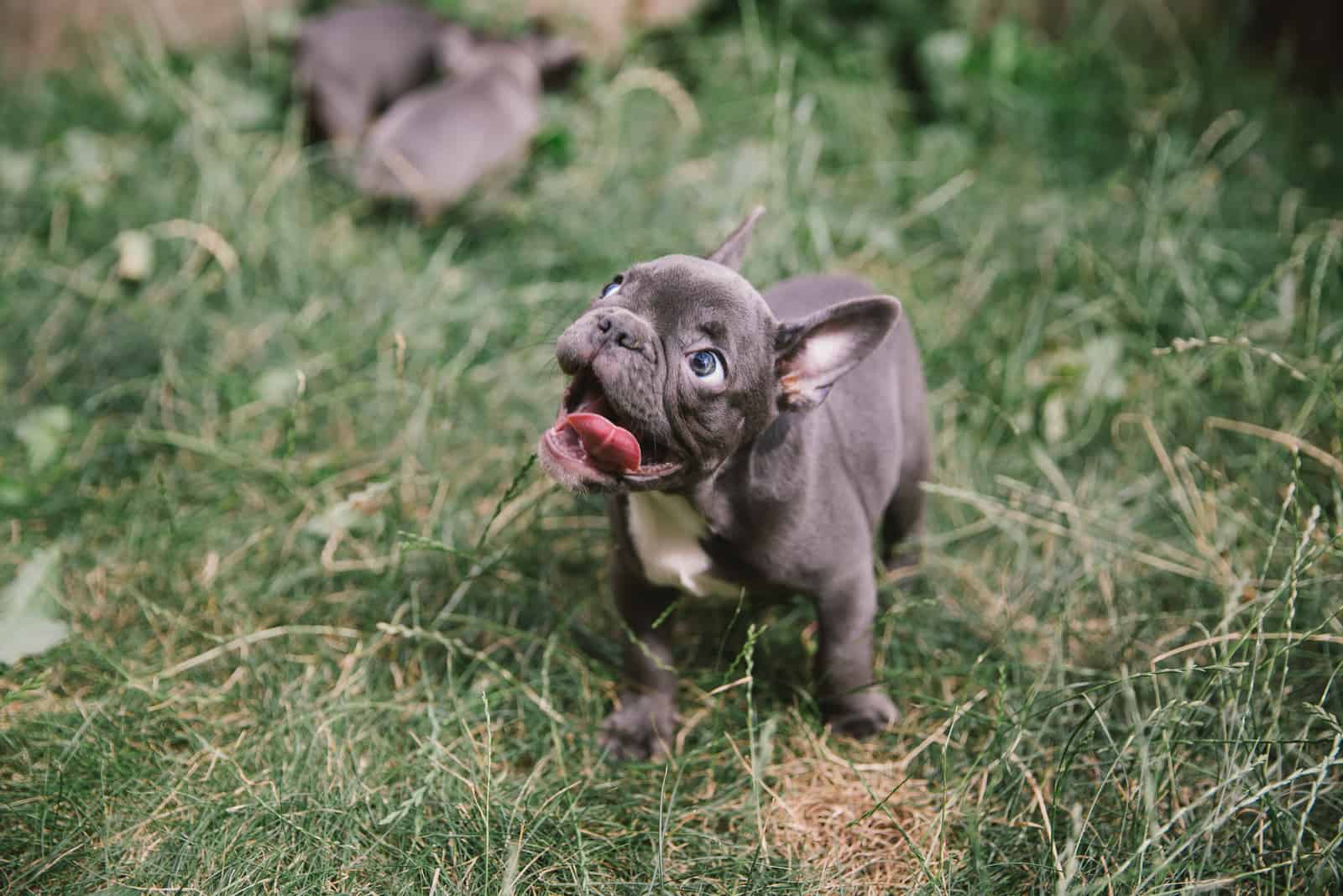Congratulations! You are about to welcome a new addition (or additions!) into your family — a French Bulldog puppy, otherwise known as a Frenchie.
Any pet is a huge responsibility, requiring dedication, commitment, and devotion. There may be sleepless nights ahead.
There will be worry and panic at times. But mostly, there will be fun, love, and enjoyment as you watch her (them) grow and thrive.
Your part in all this is essential, as they may be completely dependant on you for care and protection. And this is particularly important in the first week of their tiny lives.
It may come as a surprise, but these early stages can be fraught with danger. If they don’t get the right care and attention, then there’s a good chance that these cute little bundles might not make it.
The Dangers Of Whelping

Most Frenchie puppies won’t leave their mother and head to a new home until they are between eight and twelve weeks of age, which means that you may be caring for a whelping mother as well as her puppies.
If this is the case, you’ll need a lot of advice and support, as this can be the most difficult and dangerous time.
As with most purebreds, French Bulldogs have in-built health issues. This causes some major problems when it comes to giving birth, and special care is needed if you are to avoid the pitfalls and dangers ahead.
First, because of their large head and broad chest, natural birth is often ruled out, and a C-section is needed to safely extract the puppies (around 80% of Frenchie births are performed this way).
The mother needs to be given medication to let her body know that her babies have been born, as the natural hormones would not have been released.
Even so, with C-section births, there is a good chance that the mother won’t show any maternal instincts and might even become aggressive towards her babies.
She may not bite through the birth sacs or the umbilical cords, so you should be prepared to help out here. Not that you’re expected to use your teeth!
Special DAP (Dog Appeasing Pheremone) collars are often used to combat the problem of mother dogs not bonding with their puppies, usually starting several days before the C-section.
However, the owner or breeder should be fully prepared to step in and take over the job of caring for these tiny bundles of joy. They will need all the help and love you can give them.
Some breeders and owners prefer to allow a natural birth, despite the risks. This is more likely to be the case in Frenchies with a European bloodline, as countries there have different ‘breed standards’ that result in French Bulldogs with narrower heads and hips.
Once again, it’s important to stress that only around 20% of French Bulldog puppy births are natural. If this is the road you are choosing, it is essential to take the necessary precautions to limit the risks, particularly if this is the mother’s first time.
Being Prepared
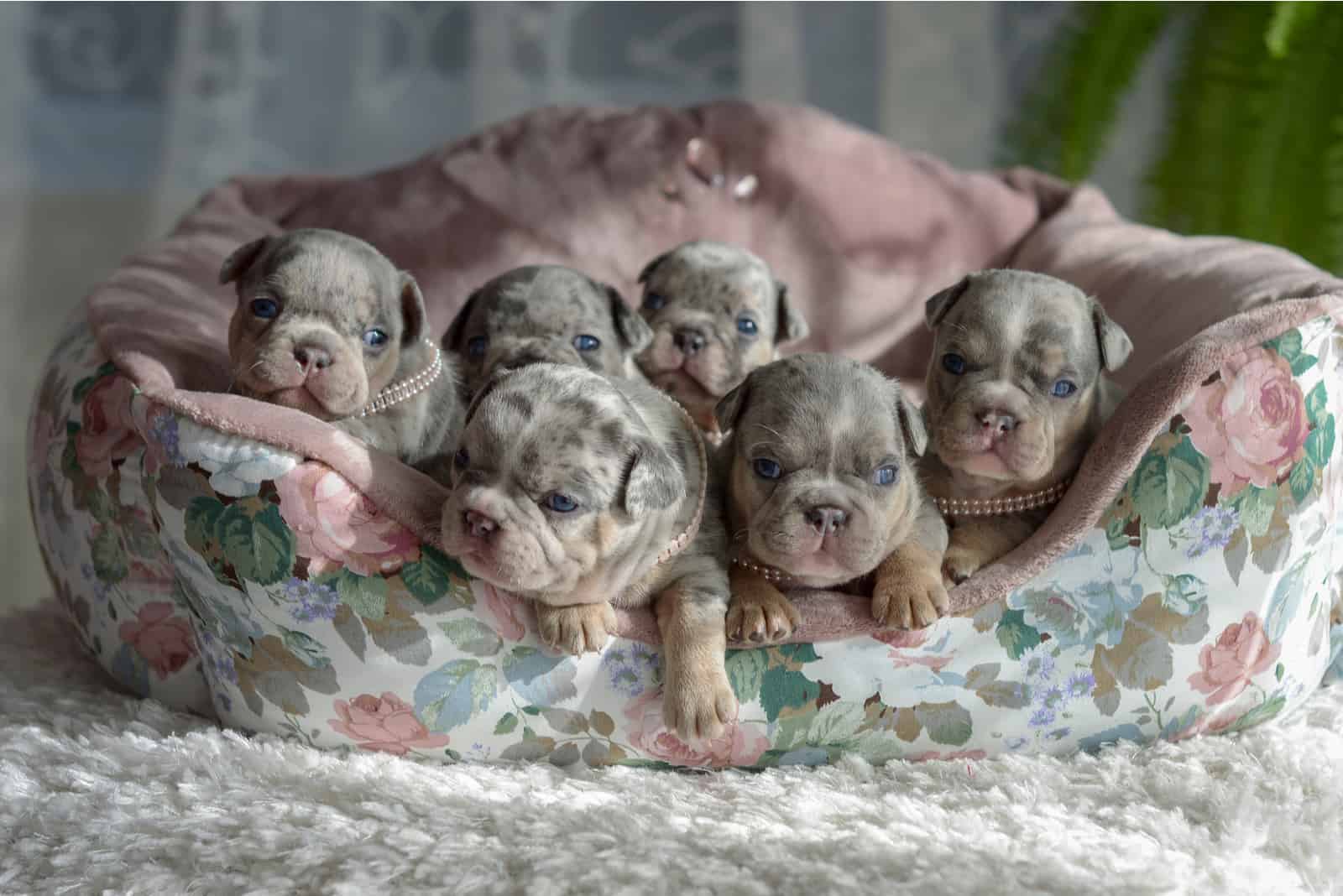
Preparation is key to the safe and successful delivery of the puppies. It pays to have everything on standby in case the mother begins to whelp before the scheduled C-section appointment. Although the date can be predicted pretty accurately, the time can be out by about 24 hours.
Here’s a guide to being prepared for the new arrivals:
• One week before the due date — Stop any flea and tick treatment.
• Prepare a whelping area several days beforehand — This should be set aside in a warm, quiet place, so they are not disturbed. Pregnant French Bulldog moms can become a touch aggressive, so it’s a good idea to limit contact with kids during this time. However gentle they usually are, they might snap at little hands that get too close.
• Whelping box — It is essential to have a safe, sterile place for the mother and her newborn puppies. Plastic whelping boxes are lightweight and easier to keep clean than wooden ones, which can harbor parasites and germs. Make sure the box is large enough for the mother to stretch out but small enough to keep her precious puppies close, with easy access for her to get out without the puppies escaping.
• Cleanliness — Keeping mom, babies, and whelping area clean is vital. Any equipment you use should preferably be sterile. Placing a plastic sheet around the whelping area and under the box will help. As will putting newspaper on the floor or using ‘puppy pads.’
It is a good idea to ensure you have any equipment you might need well in advance so that you are not taken by surprise. Here’s a list of items you might want to consider having on hand:
• Medical grade rubber gloves
• Iodine (to dab on the cut umbilical cords)
• Scales (baby scales are ideal, but anything that can measure accurately in ounces)
• Heat source (lamp, water bottle, or similar)
• Dental floss (unwaxed, to tie the cords)
• Sharp scissors (medical, if possible, but must be clean!)
• Thermometer
You might want to also keep a notebook to record birth times and weights, as well as ensuring you have the contact number for your veterinary surgery and an emergency vet hospital.
What To Expect

Photo from:@ansem.moira
When the time arrives, you’ll notice your dog starting to pace around, digging and scratching, which is a natural sign of ‘nesting.’
However, this could start a few days before when she tears up any newspaper you lay down or drags sheets and towels into a dark corner.
As the hour approaches, she will pant a lot and become restless before lying down, upon which she will begin trembling. Soon after this, she will begin to push.
The best sign of the start of labor is a sudden drop in body temperature, from around 38.5°C down to 37°C (101.3F to 98.6F), which is why it’s a good idea to keep a record of her temperature for a week or so before the due date.
Once she starts to push, the first puppy should appear within twenty minutes. If there is no sign of birth after this time, then call for assistance immediately as there is a good chance that puppy number one is stuck.
Hopefully, all will be well, and the puppy is born safely. Help momma dog out if she needs it by cleaning and cutting cords.
She should lick her babies clean as this will help her bond as the scent causes hormones to be released. Do not stop her from eating the placenta (as gross as this might seem to us, it’s a natural part of the process in the wild).
The birth process is exhausting for the mother, so help her whenever you can. It’s normal for Frenchies to have a litter of between two or three, but sometimes there are as many as five pups.
If at any time she becomes distressed, or things go wrong, call for help immediately, or both she and her Frenchie baby could be at serious risk of death.
Once all the puppies are safely delivered, cleaned, and with umbilical cords tied, then it’s time for them to feed.
Clean up the area as much as you can without disturbing them, and leave them to it.
But your work, in some senses, has only just begun!
Caring For A Newborn French Bulldog
Whether whelped at home or delivered by C-section, both mom and her new babies will need your help.
As pointed out above, dogs that deliver via a surgical procedure may not bond with their puppies, which means that they’ll be even more dependant on you.
One new puppy is a challenge. You might have two, three, or more, plus their tired mom to look after!
There is no better food at this time than the mother’s milk. However, in some cases, the mother may not naturally take to feeding.
This can be a problem when the birth has not been natural. If you need to step in, ready-made puppy formula is available, or you may wish to make your own. There are plenty of recipes out there similar to this one:
• 1/2 cup canned goats milk or evaporated milk
• 1 cup boiling water
• 1 or 2 raw egg yolks
• 1 teaspoon honey, liquid pectin, or Karo syrup
• 1 tablespoon plain yogurt
• 1 drop pediatric multivitamins
Warm the ingredients to room temperature and feed gently and slowly using a syringe or tube feeding kit. Allow enough flow to let them feed easily without it overflowing around their mouth and nose.
For the first week, they need to be fed every two hours. This can be extended to three or four hours in the second week, especially if they look healthy and are a good size.
Potty Training

Like any newborn baby, they will look to their mother for guidance, but you will most likely have to lend a hand.
They will not poop or pee of their own accord, and mom has to stimulate this action by licking them. If she doesn’t show any inclination to do this, you can use a cotton ball to gently wipe their genital area and anus, which will get them started.
In the first week, they need to pee/poop just after feeding, so you’ll be able to keep an eye on things to see if all is well. After this, you will obviously have to clean them up.
Although actual potty training won’t be something you’ll tackle until they’re a little older, it pays to start early by encouraging them to go on newspaper. They’re not the easiest breed to toilet train, so the key here is perseverance!
Start to use a command word or phrase that they can relate to the process, and (when they’re older) encourage them outdoors as soon as they start to sniff and walk in circles.
Don’t be tempted to turn this into playtime while training, as this will delay the whole procedure. Reward them once they’ve been, then take them inside as quickly as possible.
Keep Them Warm… But Not Too Warm!
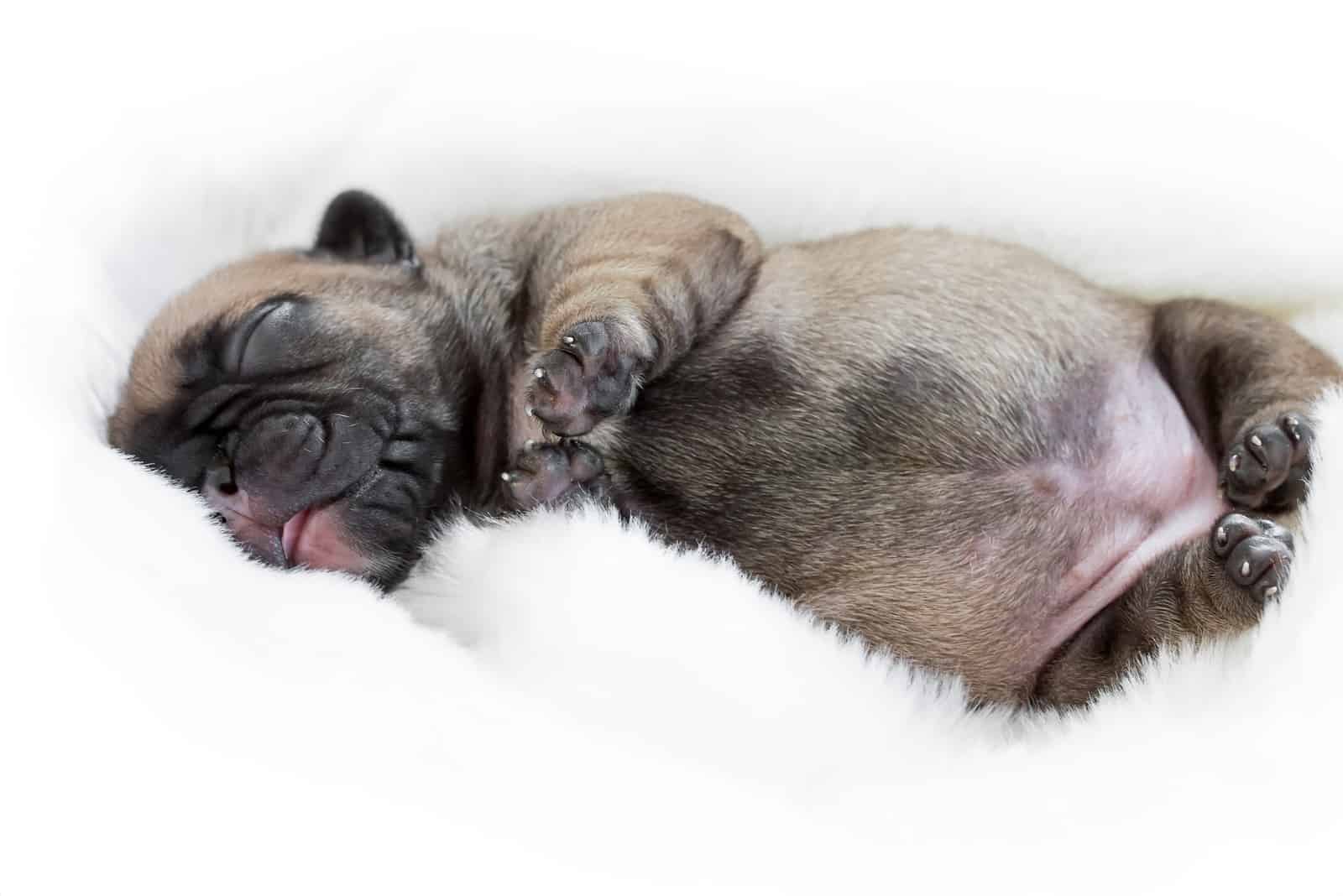
Newborn French Bulldog puppies lack the ability to regulate their own body temperature in the first week of their lives. Because of this, it is vital that you make sure they have a heat source to keep their sleeping area at a constant temperature of 83–86°F.
A good quality heat lamp or heat pad can be used, but always check that it isn’t making them too hot. Overheating can be fatal.
Check the areas for drafts and plug any gaps where cold air is flowing, but do make sure there is a slightly cooler area for mom and her babies to escape to if they want to.
An open mouth is a sign that they are too hot, but they don’t show any signs of being too cool, which can be equally as dangerous.
Frenchies, in general, due to their flat face, can be prone to overheating throughout their lives, so you should always keep this in mind.
Keep Them Clean

Any newspaper that becomes soiled should be replaced as soon as possible, and blankets or sheets should be washed regularly.
These precious pups are vulnerable to staph infections and can get sick really quickly. Diarrhea or vomiting are serious problems, leading to dehydration, which can be a killer.
If they are feeding naturally from mom, they will be getting the nutrition they need and protection in the form of antibodies to help fight infection.
If, on the other hand, they aren’t able to feed naturally, extra care should be taken to avoid sources of infection.
Development
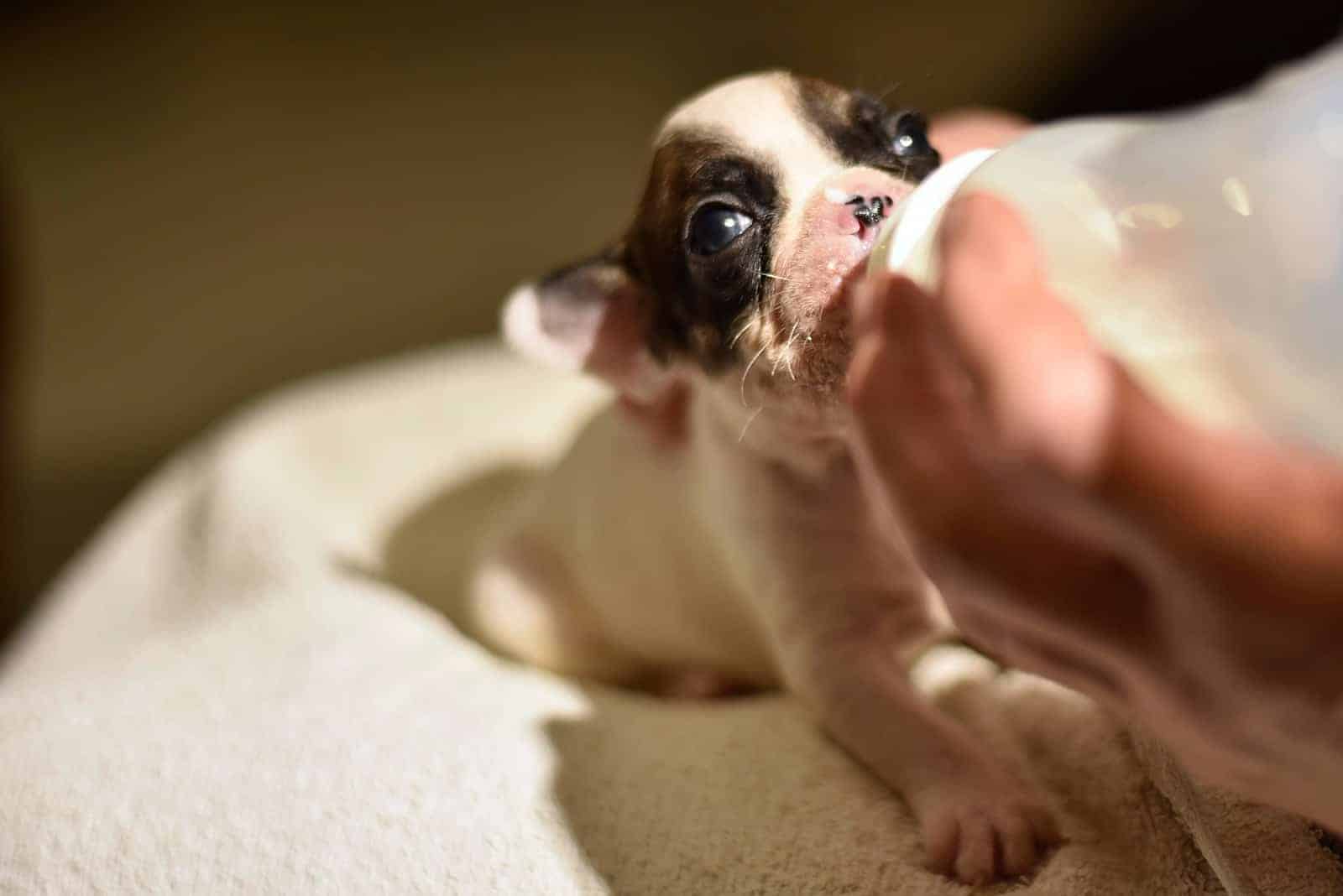
They will need to nurse or be fed formula for about three to four weeks before weaning. By this time, they will have changed significantly. When born, and for the first week, they are blind, deaf, and only able to move by wriggling.
In their second week, they will begin looking around, though their eyes aren’t working fully yet. They will also react to sound even though their ears are just starting to open.
At three weeks, big changes start to take place, and they’ll be getting adventurous. It’s a good idea to keep a careful eye on them and make sure mom’s water bowl isn’t accessible, as they could fall in and not be able to get out!
By now, they are able to defecate and urinate by themselves, without help.
And once they reach week four, they have tiny teeth, which means it’s time to start the weaning process. You might see signs of ‘socializing’ as they play and interact with siblings.
This is a good time to begin things like toilet training. Place a shallow water bowl within reach, and be sure to remove any small objects from the area as they are likely to choke on them!
By week five, weaning should be in full swing, with a gradual move away from relying on mother’s milk and onto completely solid food.
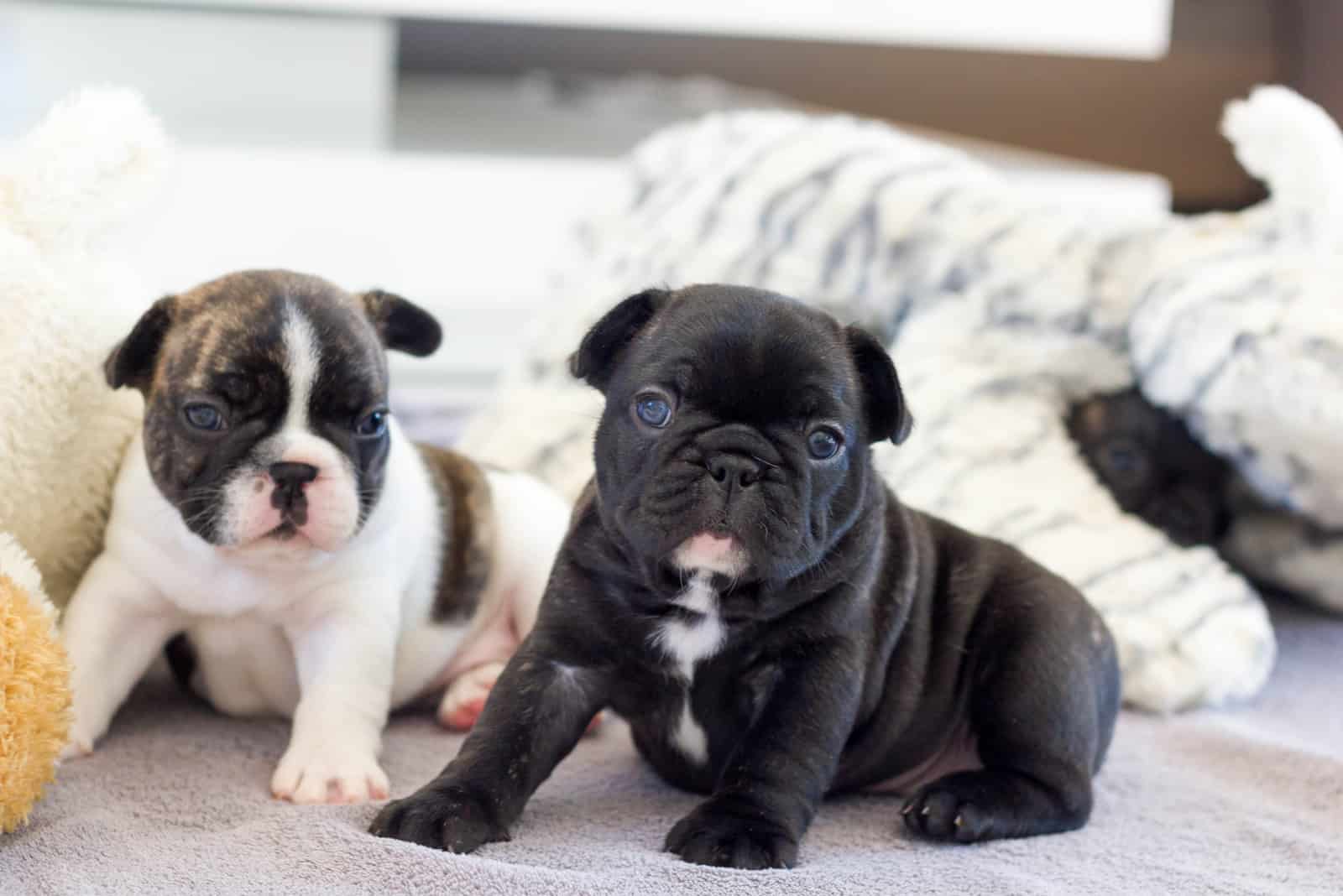
This is the stage at which you might encounter the dreaded ‘nibbling and chewing’ habit! They will be more independent and will play with their siblings, sometimes getting pretty rough.
By the sixth week, they should be fully weaned and eating good-quality puppy food. Although they seem strong and independent, it’s still too early for them to leave the safety of their den.
As well as interacting with their siblings and mother, they should be showing interest in humans too. This is the time to book them in for vaccinations.
Now we reach the ‘fear’ stage! Up to this point, the puppies have been courageously investigating their little world, their natural curiosity overcoming any fears.
Now, however, they should start to display caution, especially with new objects or experiences. It’s good to encourage this, but don’t push too hard too soon as this important step helps shape their future personality and behavior.
An eight-week-old French Bulldog puppy should now be fully formed, with deep brown eyes and weighing between 5 and 7 pounds. They’re ready to go to their new owners if that’s the future in store for them.
As loyal, fun, playful, and cute as they can be, this breed faces a host of health issues. They require special care and consideration, and you should only take them on if you are prepared to do what it takes to keep them healthy and give them the love they deserve.
Read Next: French Bulldog Feeding Chart: How To Keep Your Frenchie Fit
